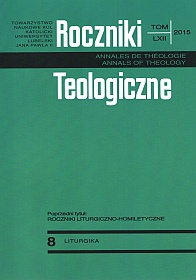Liturgy as an Image
Abstract
Important for this article is to look at the liturgy from the perspective of its celebration. The celebration, i.e. the visible side of the liturgy, so the congregation and its external action (postures, gestures), liturgical space, vestments, paraments and the whole ars celebrandi, is the image of the liturgy invisible to the human eye, yet the image of this reality, which takes place inside the gathered people. The liturgical celebration is first and foremost the image of the cosmic liturgy. Christ, the Church, man, and with him the world, meet in the liturgy. Christ reveals Himself as Head of the Church and Lord of the entire universe. Man becomes a new icon of God, in the image of Christ, and the whole world regains in man the glory of God. All this contains an important message to persons responsible for the ars celebrandi and for the creation of liturgical space.
References
Accart X.: Comprendre et vivre la liturgie : signes et symboles expliqués à tous. Paris: Presse de la Renaissance 2009.
Borobio D.: Historia y teología comparada de los sacramentos. El principio de la analogía sacramental. Salamanca: Sigueme 2012.
Kaspersen S., Haastrup U. (red.): Images of Cult and Devotion. Function and Reception of Christian images in Medieval and Post-medieval Europe. Copenhagen: Museum Tusculanum Press 2004;
Kardaszewski T.: L’Arche du Seigneur. Guide historique et symbolique. Kraków-Tyniec: Wydawnictwo Benedyktynów 2004.
Schreijäck T. (red.): Pas d’image. Kunst erschließt Welten und die Theologie. Münster: LIT 2005.
Rorem P.: Biblical and Liturgical Symbols Within the Pseudo-Dionysian Synthesis. Toronto: Pontifical Institute of Mediaeval Studies 1984;
Walker K.: Images or Idols? The Place of Sacred Art in Churches Today. Norwich: Canterbury Press 1996.
Copyright (c) 2015 Roczniki Teologiczne

This work is licensed under a Creative Commons Attribution-NonCommercial-NoDerivatives 4.0 International License.





